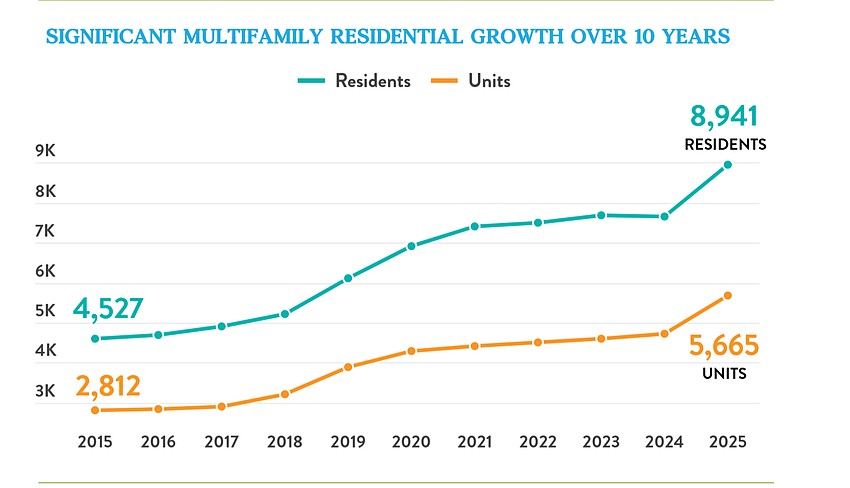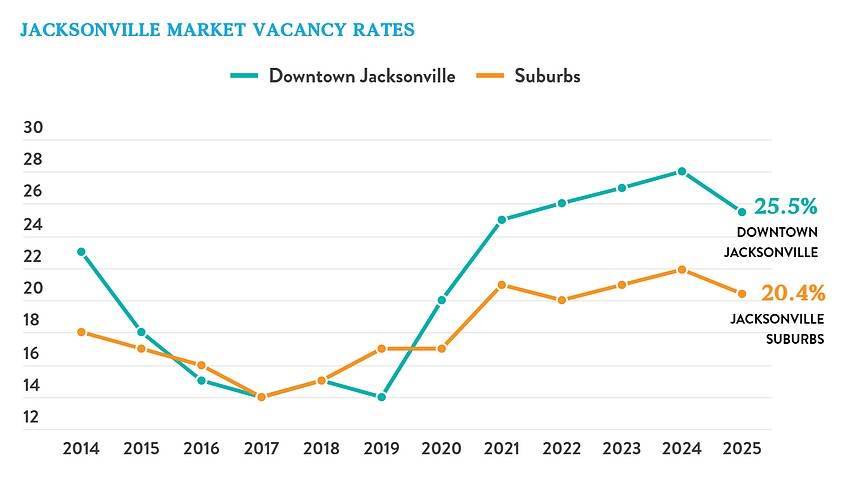
With office vacancy still running well above pre-pandemic levels in the core of Jacksonville, members of a panel on Downtown revitalization said Nov. 20 that a key to filling empty commercial spaces was to continue nurturing public and private developments that would make Downtown a more attractive place to live and visit.
During a discussion titled “Downtown Rising: Jacksonville’s Long-Awaited Transformation Takes Shape,” panel members said that offering incentives for residential and retail projects while continuing to build public parks would draw more long-term residents Downtown while also attracting visitors.

A larger Downtown resident population would in turn attract employers, who could offer employees a chance to work close to home.
“The CEOs making those decisions (about where to establish workplaces) are going to listen to their employees, I hope,” said Colin Tarbert, CEO of the Downtown Investment Authority.
“And if their employees want to be Downtown, they (companies) will come Downtown.”
Tarbert said it would be difficult for the DIA to resolve high office vacancy rates, an issue occurring in downtowns across the U.S.

Instead of dealing with it head-on, he said, the DIA would be better served by advancing projects like the $2 billion Gateway Jax mixed-use development, University of Florida graduate campus, Riverfront Plaza park and others that are designed to increase the quality of life in Downtown.
The idea is that with more places for dining, shopping and recreation, Downtown can attract more residents and, in turn, more employers.
Bisnow, a Washington, D.C.-based digital media company that reports about the commercial real estate industry and sponsors events, hosted the panel at The River Club in Downtown. The panel was part of Bisnow’s Jacksonville Construction & Development Summit.
Downtown vacancy
Vacancy in Downtown offices has been at 25% or higher since 2021, according to Downtown Vision Inc.’s annual State of Downtown report, and Jacksonville industry market reports show rates of 28.1% to 28.8% as of the end of the third quarter, in September.

Jacksonville’s Downtown vacancy is higher than the national or state averages while also outpacing vacancy in the city’s suburbs.
“We’re losing a lot of our offices Downtown,” said Mark Balanky, president and CEO of Chase Properties.
“So we may have some momentum in some areas, but we’re losing it in others. We need to keep our office space front of mind Downtown.”
Alex Sifakis, president of JWB Real Estate Capital, agreed that vacancy was a challenge and said the rate may rise.
“I wouldn’t be surprised if we have more office defections in the next year or two,” he said.
Sifakis noted that his company is moving its headquarters in February to the Greenleaf & Crosby Building, which is under renovation Downtown. That move will bring 130 workers to Downtown.
More are leaving
Among outbound moves already in motion, Citizens Property Insurance Corp. plans to relocate in January 2026 from the 30-story EverBank Center at 301 W. Bay St. to the former Florida Coastal School of Law building at 8787 Baypine Road.
The state insurer chose a bid for space in the former law building in March 2025.
On Nov. 4, the Duval County School Board voted to sell its headquarters at 1701 Prudential Drive to Chase Properties and purchase a building at 8928 Prominence Parkway in Baymeadows to become its new central offices.
Chase plans to demolish the DCPS building and build a riverfront high-rise with 300 condominiums, 300 apartments and 200,000 square feet of commercial and retail space.

Among other topics, the panelists credited recent gains by Downtown – the $1.4 billion “Stadium of the Future” renovation, the nearby Four Seasons Hotel & Residences project, a proposed Publix as part of the Gateway Jax project and more – to alignment of political leaders in support of Downtown.
Sifakis said Downtown was reaching a tipping point where incentives would no longer be necessary to make projects financially feasible.
“But over the next two to four years, these projects will still need pretty significant incentives to get them off the ground,” he said. “We need to make sure we’re supporting our politicians and local government to ensure we continue to invest incentives in Downtown.”